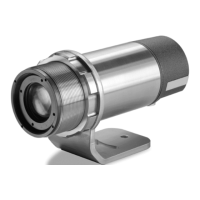Operation
Marathon MM Rev. D7 Jul 2017 45
7.4.3.2 Ambient Background Temperature Compensation
The sensor is capable of improving the accuracy of target temperature measurements by taking into
account the ambient or background temperature. This feature is useful when the target emissivity is
below 1.0 and the background temperature is not significantly lower than the target temperature. For
instance, the higher temperature of a furnace wall could lead to too-high temperatures being measured
especially for lower emissivity targets. A built in ambient background temperature compensation utility
compensates for the impact of the reflected radiation in accordance to the reflective behavior of the
target. Due to the surface structure of the target, some amount of ambient radiation will be reflected
and therefore added to the thermal radiation that is collected by the sensor. The ambient background
temperature compensation compensates the final result by subtracting the amount of ambient radiation
measured from the sum of thermal radiation the sensor is exposed to.
The ambient background temperature compensation should always be activated in case
of lower emissivity targets in conjunction with targets cooler than the surrounding
environment or heat sources near to the target!
Three possibilities for ambient background temperature compensation are available:
The internal sensor temperature is utilized for compensation assuming that the ambient
background temperature is more or less represented by the internal sensor temperature. This is
the default setting.
If the background ambient temperature is known and constant, the user may input the known
ambient temperature as a constant temperature value.
Ambient background temperature compensation from a second temperature sensor (infrared
or contact sensor) ensures extremely accurate results. An analog voltage signal at the external
input (0 to 5 VDC) is utilized for real time compensation. The voltage input signal is wired to
the trigger input terminal of the Marathon terminal block. If an infrared temperature sensor is
used for background compensation, both sensors must be set on the same temperature range.

